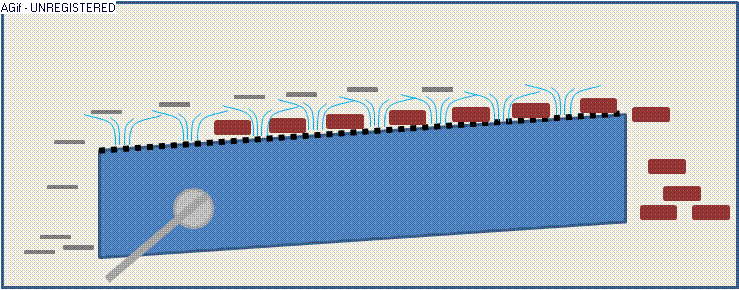My Projects
Topic: Mass Flow Sorting
Title: Separation of Mixed Plastic Parts on a Jig

The animation illustrates the processes on an air jig, i.e. a vibrating chute combined with a sifter.
Particles with a high load are in contact with the chute …
… and therefore conveyed by an eccentric stroke to the upper end.
Particles with a low load are suspended by an upward airflow of the sifter …
… and hover on an air cushion to the lower end of the jig.
What one doesn’t see:
The particles on an air jig are fluidized by vibration and airflow, which causes a perpetual replacement and material drift. Particles with less contact to the sifter follow mainly the force of gravity, whereas particles with friction to the chute get a momentum by the oscillating support. By a suitable inclination of the jig a compulsory “relocation” of the different particles is obtained, i.e. the heavy particles propagate to the upper end, whereas the light particles drift to the lower end of the air jig. The appropriate conditions are adjustable by means of the air flow rate, the eccentric stroke amplitude, and frequency as well as the inclination of the sifter and its specifications, e.g. size, form, and bulge of the gap holes.
What’s behind it:
Due to the compulsory “relocation” – as previously explained – the classification of different particles is quite accurate. In the case of similar forms of the particles, a sorting by differences in density is feasible. In the case of similar density, a sorting by differences in form can be achieved, since the load is the result of the weight and the area covered.
What you can obtain from it:
“To separate the wheat from the chaff” is a common saying which has its origin in mass flow sorting. Although the plant materials have a similar density, the chaff is more volatile in an air current due to its form than the bulky grains of wheat. However, it may occur that grainy stones get mixed with the wheat. Then, the non-volatile grains can be separated by an air jig. For the processing of mixed plastic materials, the conditions are comparable: Plastics have a similar density to plants and plastic composites in manufacture occur often in different forms. For example, many composites are coated with a plastic layer, which can be separated after disintegration (like the chaff) from the more compact components.
My related publications:
Process for Disintegration and Pure-Sorted Separation of Recyclable Different Plastics of Composite Structural Parts, patent US 5297741 A (1994)
Material Recovery from Automotive Composites, Macplas International 5, 44-45 (1994)
Recycling Techniques, Plastic Composites, in Polymer Materials Encyclopedia, CRC Press Vol. 10, pp7419-7428 (1996)
Separation Technologies for the Recycling of Metals, Proceedings R’97 III, pp 45-50 Geneve,Switzerland (1997)
Sorting of Mixed Plastic Parts by Flotation, XX International Mineral Processing Congress, Aachen, Germany (1997)